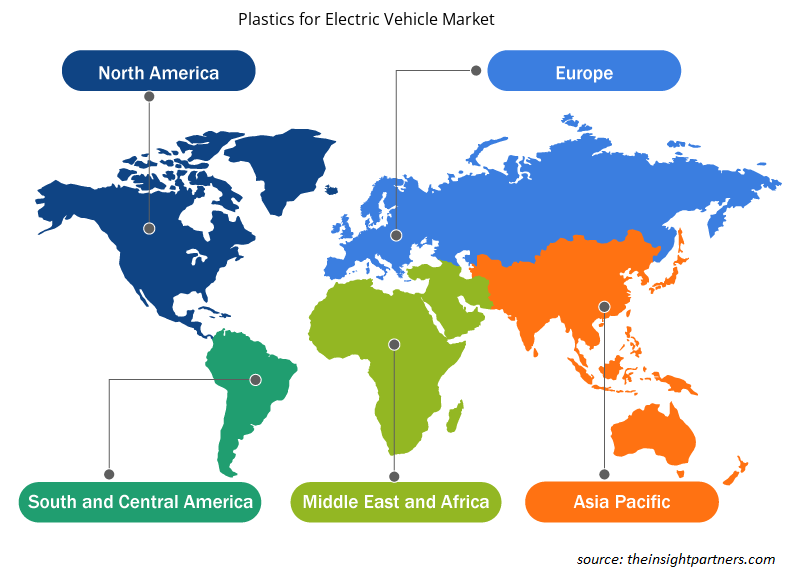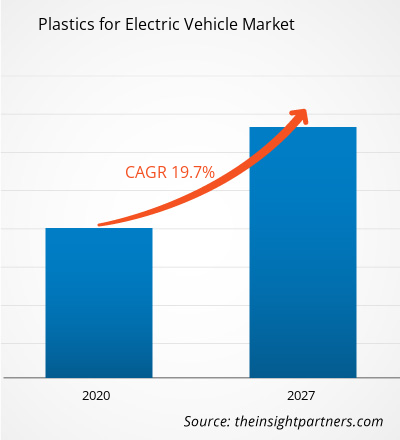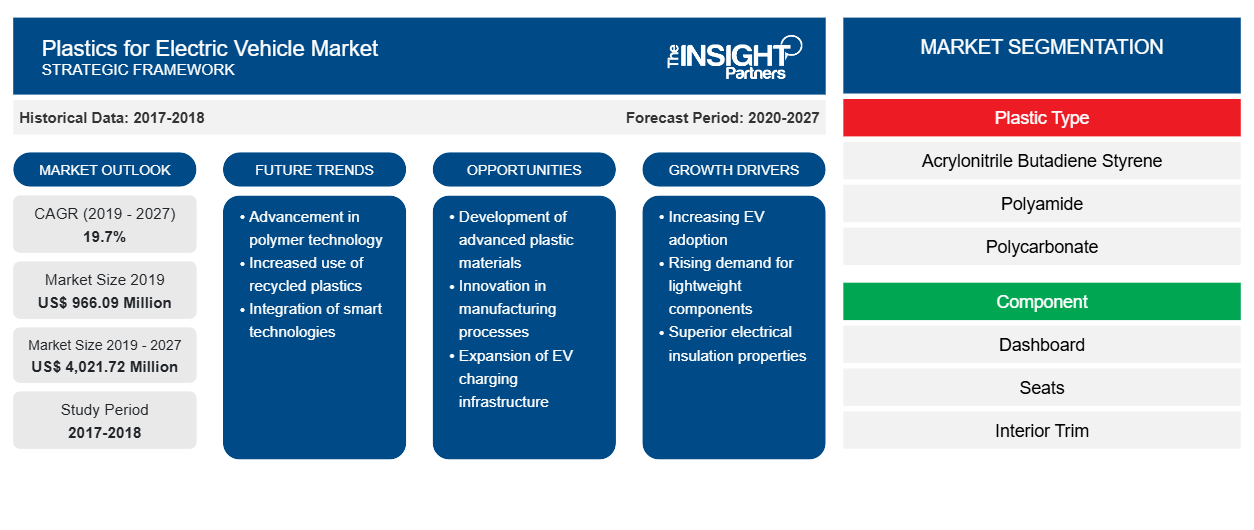2019 年电动汽车塑料市场价值为 9.6609 亿美元,预计到 2027 年将达到 40.2172 亿美元;预计 2020 年至 2027 年的复合年增长率为 19.7%。
塑料既可以作为电导体,也可以作为绝缘体。由于塑料用途广泛且易于成型,因此可以根据电动汽车的要求生产各种形状和设计。电动汽车使用塑料可以减轻汽车重量,从而增加充电间隔。塑料具有出色的耐热性,可用于构建电池舱和冷却系统,并且不会影响电动汽车的耐用性和安全性。预计 2020-2027 年期间,北美电动汽车用塑料市场将以 20.0% 的最高复合年增长率增长。
2019 年 12 月,武汉首次报告了 COVID-19 疫情。截至 2020 年 6 月,美国、俄罗斯、印度、西班牙、巴西、意大利、法国和德国是 COVID-19 确诊病例和死亡人数最多的国家。由于封锁、旅行禁令和企业停业,疫情对经济和行业产生了不利影响。化学品和材料是世界主要行业之一,受到供应链中断、技术活动取消和办公室关闭等严重影响。中国是全球制造业中心,也是全球各行业最大的原材料供应国,也是受 COVID-19 疫情影响最严重的国家之一。中国各工厂的封锁限制了全球供应链以及各种化学品和材料产品的制造和销售。因此,疫情的整体影响抑制了电动汽车用塑料市场的增长。
定制此报告以满足您的需求
您可以免费定制任何报告,包括本报告的部分内容、国家级分析、Excel 数据包,以及为初创企业和大学提供优惠和折扣
- 获取此报告的关键市场趋势。这个免费样品将包括数据分析,从市场趋势到估计和预测。
市场洞察
电动汽车需求增长推动市场增长
随着人们越来越重视环境可持续性,汽车制造业正朝着减少温室气体排放和提高燃油效率的方向发展。成本效益、环境可持续性、便利性、采用先进技术以及各种政府政策(如优惠费率、设备购买激励措施和大幅回扣)是推动全球电动汽车需求的因素之一。根据国际能源署的数据,2019 年全球电动汽车销量同比增长 40%,达到 210 万辆,大大超过 2018 年。
塑料类型洞察
根据塑料类型,电动汽车用塑料市场细分为丙烯腈丁二烯苯乙烯 (ABS)、聚酰胺 (PA)、聚碳酸酯 (PC)、聚乙烯醇缩丁醛、聚氨酯 (PU)、聚丙烯 (PP) 等。聚丙烯 (PP) 部分在 2019 年占据了最大的市场份额。聚丙烯 (PP) 是指由丙烯单体组合而成的热塑性“加成聚合物”。它坚硬且结晶;因此,它被广泛用于制造包装托盘、医疗设备等物品。作为聚烯烃树脂的重要家族之一,它可以模塑和挤压成任何需要柔韧性、韧性、重量轻和耐热性的塑料类型。
组件洞察
根据组件,电动汽车塑料市场细分为仪表板、座椅、内饰、汽车内饰、保险杠等。内饰部分在 2019 年占据了最大的市场份额。电动汽车的内饰是指车厢内的塑料部件或面板。具有令人愉悦的功能和美观装饰对于提供完美的内部体验至关重要。
车辆类型洞察
根据车辆类型,电动汽车塑料市场分为 BEV 和 PHEV/HEV。BEV 细分市场在 2019 年占据了最大的市场份额。纯电动汽车或 BEV 使用高容量电池组在车上储存电力。电池中的电力用于运行电动机和车上的其他电子设备。塑料用于制造电动汽车所需电气元件的连接器和外壳。
应用程序洞察
根据应用,电动汽车用塑料市场进一步细分为动力系统/引擎盖下、外部、内部以及照明和电线。内饰部分在 2019 年占据了最大的市场份额。高性能塑料用于电动汽车,提供安全性和保障。聚丙烯经常用于汽车零部件,例如汽油罐和内饰地板的地毯纤维。PVC 因其光滑的表面而用于汽车油箱和仪表板。方向盘和仪表板也采用丙烯腈丁二烯苯乙烯或 ABS 塑料生产。塑料在方向盘、内饰地板和控制台中的广泛应用有利于电动汽车用塑料内饰市场的增长。
电动汽车用塑料市场区域洞察
Insight Partners 的分析师已详细解释了预测期内影响电动汽车塑料市场的区域趋势和因素。本节还讨论了北美、欧洲、亚太地区、中东和非洲以及南美和中美洲的电动汽车塑料市场细分和地理位置。

- 获取电动汽车市场塑料的区域特定数据
电动汽车用塑料市场报告范围
| 报告属性 | 细节 |
|---|---|
| 2019 年市场规模 | 9.6609亿美元 |
| 2027 年市场规模 | 40.2172亿美元 |
| 全球复合年增长率(2019 - 2027) | 19.7% |
| 史料 | 2017-2018 |
| 预测期 | 2020-2027 |
| 涵盖的领域 | 按塑料类型
|
| 覆盖地区和国家 | 北美
|
| 市场领导者和主要公司简介 |
|
电动汽车市场参与者的塑料密度:了解其对业务动态的影响
电动汽车塑料市场正在快速增长,这得益于终端用户需求的不断增长,而这些需求又源于消费者偏好的不断变化、技术进步以及对产品优势的认识不断提高等因素。随着需求的增加,企业正在扩大其产品范围,进行创新以满足消费者的需求,并利用新兴趋势,从而进一步推动市场增长。
市场参与者密度是指在特定市场或行业内运营的企业或公司的分布情况。它表明在给定市场空间中,相对于其规模或总市场价值,有多少竞争对手(市场参与者)存在。
在电动汽车塑料市场运营的主要公司有:
- 巴斯夫
- 索尔维公司
- 杜邦公司
- 陶氏化学公司
- LG化学有限公司
免责声明:上面列出的公司没有按照任何特定顺序排列。

- 了解电动汽车塑料市场的主要参与者概况
报告亮点
- 全球电动汽车塑料市场的进步行业趋势有助于参与者制定有效的长期战略
- 发达市场和发展中市场采用的业务增长战略
- 2017年至2027年电动汽车用塑料市场定量分析
- 全球各行业电动汽车塑料需求估算
- PEST 分析说明市场中买家和供应商的运作效率
- 了解竞争激烈的市场形势和电动汽车对塑料的需求的最新发展
- 市场趋势和前景,以及推动和抑制市场增长的因素
- 了解支撑全球电动汽车塑料市场增长的战略,帮助利益相关者做出决策
- 电动汽车用塑料市场各市场节点规模
- 市场详细概述和细分以及行业动态
- 全球电动汽车用塑料市场各地区规模及各地区增长机遇
电动汽车市场用塑料,按塑料类型划分
- 丙烯腈丁二烯苯乙烯
- 聚酰胺
- 聚碳酸酯
- 聚乙烯醇缩丁醛
- 聚氨酯
- 聚丙烯
- 其他的
电动汽车市场塑料(按组件划分)
- 仪表板
- 座位
- 内饰
- 汽车内饰
- 保险杠
- 其他的
电动汽车市场塑料,按车型分类
- 纯电动汽车
- 插电式混合动力汽车/混合动力汽车
电动汽车市场塑料的应用
- 动力传动系统/ 引擎盖下
- 外部的
- 内部的
- 照明和电线
公司简介
- 巴斯夫
- 索尔维公司
- 杜邦公司
- 陶氏化学公司
- LG化学有限公司
- 朗盛公司
- 沙特基础工业公司
- 科思创公司
- 旭化成公司
- 利安德巴塞尔工业控股有限公司
- 历史分析(2 年)、基准年、预测(7 年)及复合年增长率
- PEST和SWOT分析
- 市场规模、价值/数量 - 全球、区域、国家
- 行业和竞争格局
- Excel 数据集
近期报告
相关报告
客户评价
购买理由
- 明智的决策
- 了解市场动态
- 竞争分析
- 客户洞察
- 市场预测
- 风险规避
- 战略规划
- 投资论证
- 识别新兴市场
- 优化营销策略
- 提升运营效率
- 顺应监管趋势























 获取免费样品 - 电动汽车市场塑料
获取免费样品 - 电动汽车市场塑料